Farmhouse living rooms offer a homey, warm, nostalgic, and timeless appeal, often characterized by central fireplaces, decorative beams, shiplap, barn doors, vintage lighting, and neutral colors.
Natural materials like wood, metal, and stone are central to their cozy design. Farmhouse style’s versatility allows it to blend seamlessly with modern minimalist or traditional homes.
While classic farmhouse leans towards warmer tones and darker woods, modern farmhouse favors white walls and lighter woods for a bright, contemporary feel.
Today, many also create hybrid styles like coastal, industrial, or boho farmhouse.
Whether renovating or building new, explore these farmhouse living rooms for inspiring ideas.
Start with Shiplap
:strip_icc():format(webp)/modern-farmhouse-living-room-sliding-doors-ffed9d26-3cc7b6bae8134298b69680860c90e2eb.jpg)
It’s no secret shiplap has become a huge design trend over the past decade, making its way from home shows to Pinterest boards.
With its clean lines and wide planks, shiplap makes the perfect backdrop in this modern farmhouse.
A plaster fireplace soars to the vaulted ceiling and stands out among neutral furnishings.
Modern Eclectic
:strip_icc():format(webp)/white-farmhouse-living-room-mantle-brick-fireplace-2319df84-d0fafb9f56724a79a55102994fc07897.jpg)
Sliding barn doors are a sure sign of farmhouse style.
These salvaged beauties were refinished and stained caramel for a warm contrast to the stone and concrete elements in this modern farmhouse living room.
The caramel-color stitched-leather butterfly chairs continue the color scheme.
Farmhouse Furniture
:strip_icc():format(webp)/farmhouse-style-music-room-piano-491714b1-5d660e8eeb8f45949078425a57d8c1c8.jpg)
Consider slipcovers when furnishing your farmhouse living room.
The practical update makes it possible to decorate with creamy white fabrics without the fear of permanent stains.
Here, white slipcovered chairs provide a canvas for alluring blue accents.
A weathered brick fireplace is the perfectly imperfect centerpiece in this otherwise polished room.
Eclectic Mix
:strip_icc():format(webp)/bright-farmhouse-living-room-wicker-accents-9650db4b-989e1d82e5da42fe93710ac2cbadc2ca.jpg)
This farmhouse family room is a little bit country, a little bit rock ‘n’ roll.
The mounted banjo and guitar, a 19th-century piano, and graphic poster are noteworthy against the paneled accent wall and neutral furnishings that ground the living room in farmhouse style.
An animal hide rug on a vibrant pink oriental rug adds eclecticism.
Bright White Walls
:strip_icc():format(webp)/farmhouse-living-room-blue-rug-wood-accents-5835fb74-f966521666b64f499ede015caa15937d.jpg)
Neutral walls and lots of natural lighting are hallmarks of farmhouse style.
This crisp white living room allows wicker accents and fresh greenery to take center stage.
Wood accents—the mantel, pendant light fixture, a mounted basket, and vintage crates—warm the color scheme.
Cozy Cabin Details
:strip_icc():format(webp)/farmhouse-style-room-bright-pillows-and-accents-cd1bbbbc-3c1ee563ee224d63bf6837b4a20a88e3.jpg)
Distressed woods juxtapose matte metals in this farmhouse living room.
Black metal on the sconces, window trim, and ceiling fan add a little drama.
Coastal elements, like navy blue accents and a nautical-theme coffee table, allude to the home’s lakeside location.
Cottage Appeal
:strip_icc():format(webp)/modern-farmhouse-living-room-black-wall-6b281327-f20bd083c0ee477a909ddfe063fcb4a8.jpg)
Found items bring charming country touches into this shabby-chic farmhouse.
An old barn ladder showcases favorite throw blankets.
Caster wheels found on Craigslist give a chicken crate a lift, making it the right height for a coffee table.
IKEA sofas wearing white slipcovers provide a blank slate for piles of patterned throw pillows.
Updated Shiplap Walls
:strip_icc():format(webp)/farmhouse-style-room-modern-furniture-28f96dc1-fa7b6816214d458ca579de11d5e44fd1.jpg)
Cowhide chairs, shiplap walls, exposed beams—all are traditional markers of farmhouse style.
However, this home modernized the look by installing the shiplap vertically then painting usually white shiplap dark gray.
The contemporary accent wall provides sharp relief for a light beige tailored sofa and artwork.
Modern Farmhouse Style
:strip_icc():format(webp)/farmhouse-living-room-white-walls-antlers-b6830e3b-a159792550444f35a33fd7922dcd075c.jpg)
No chicken motifs here!
Contemporary elements, such as a sleek shiplap fireplace, midcentury modern seating, and a concrete coffee table, lend modern farmhouse style to this space.
A few pops of turquoise, pink, and yellow warm the otherwise neutral furnishings.
Bring Farmhouse Charm with Wooden Ladder Photo Display
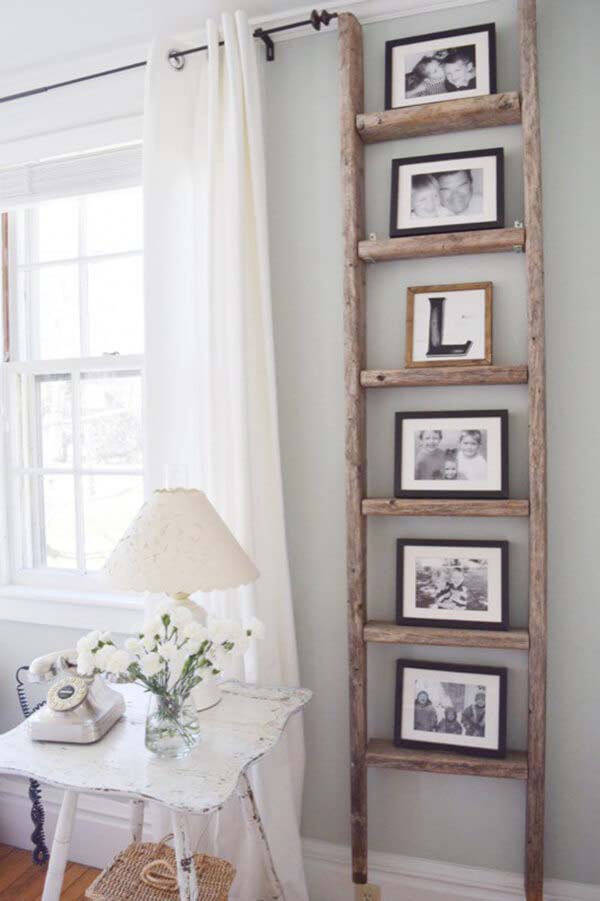
This farmhouse-style living room idea lets you add a personal touch to the interior in a space-saving way.
A painter’s ladder is repurposed into a photo shelf by fixing it on the wall with suitable hardware.
Adjacent vintage side table displays antique elements to enhance the farmhouse vibe.
Capture Autumn Ambiance with a Pumpkin End Table Display
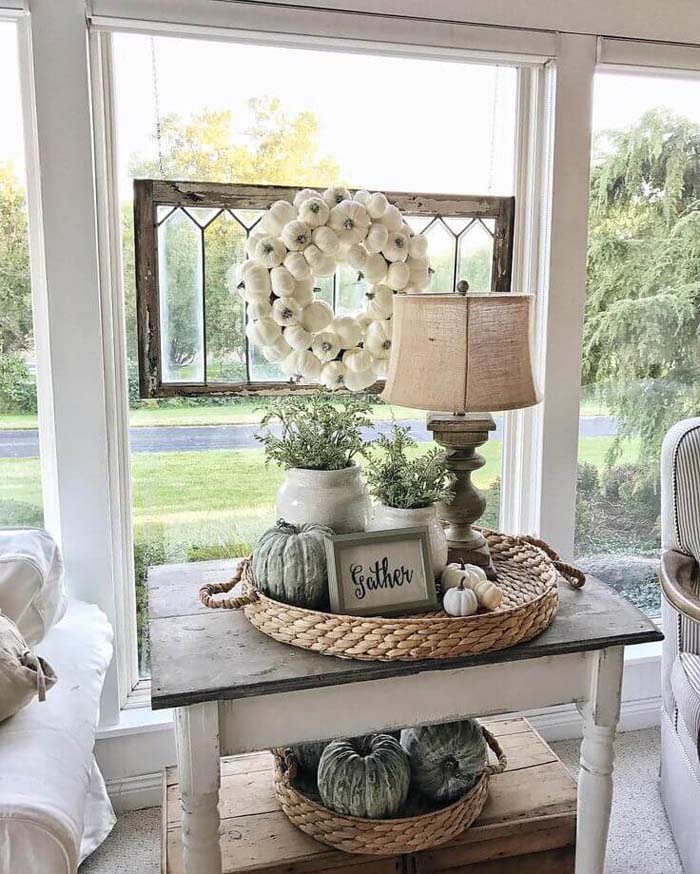
Welcome the autumn season with a farmhouse display celebrating the harvest.
A side table made from reclaimed furniture pieces becomes a stand of a wicker tray centerpiece.
Pumpkins in various sizes surround rustic planters and a wooden candlestick.
You can make another tier for farmhouse accents by placing a wooden chest, crate or vintage trunk.
Upcycle Pallet Slats into Rustic Chevron Wall Decor
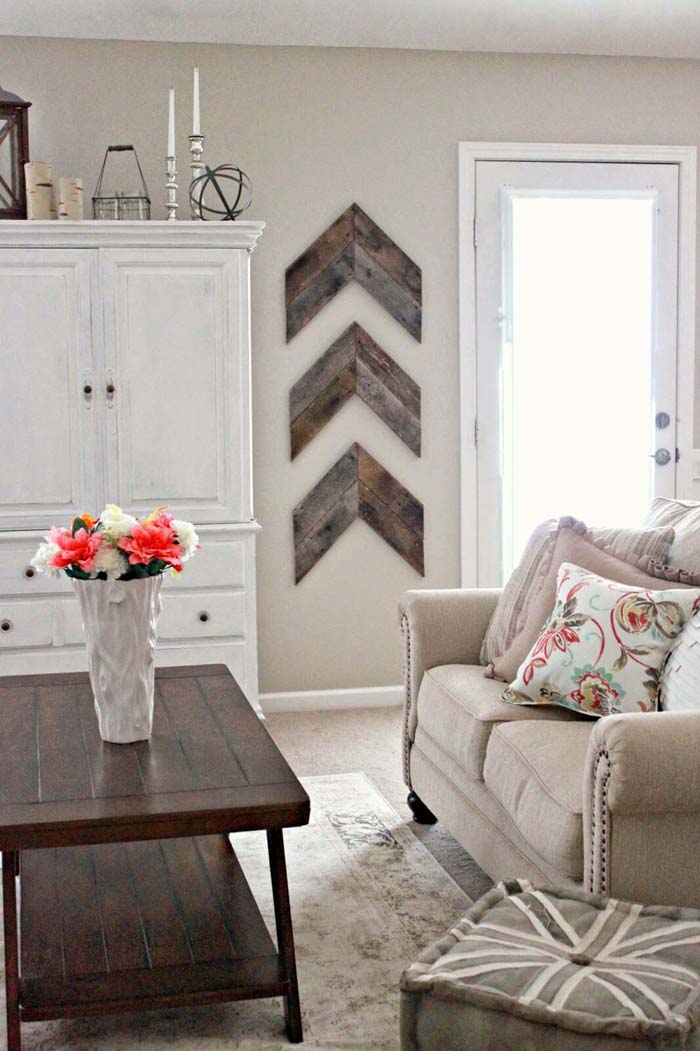
Create an authentic rustic wall decor with wooden slats.
You can upcycle laminate leftovers or pallet slats for this DIY farmhouse living room decor.
Arrange the slats in a chevron pattern mimicking three arrows. You can place them vertically or horizontally.
For an enhanced rustic farmhouse effect, you can use barn wood, especially if it has signs of wearing.
Adorn a Boxwood Wreath with a Recycled Window Frame
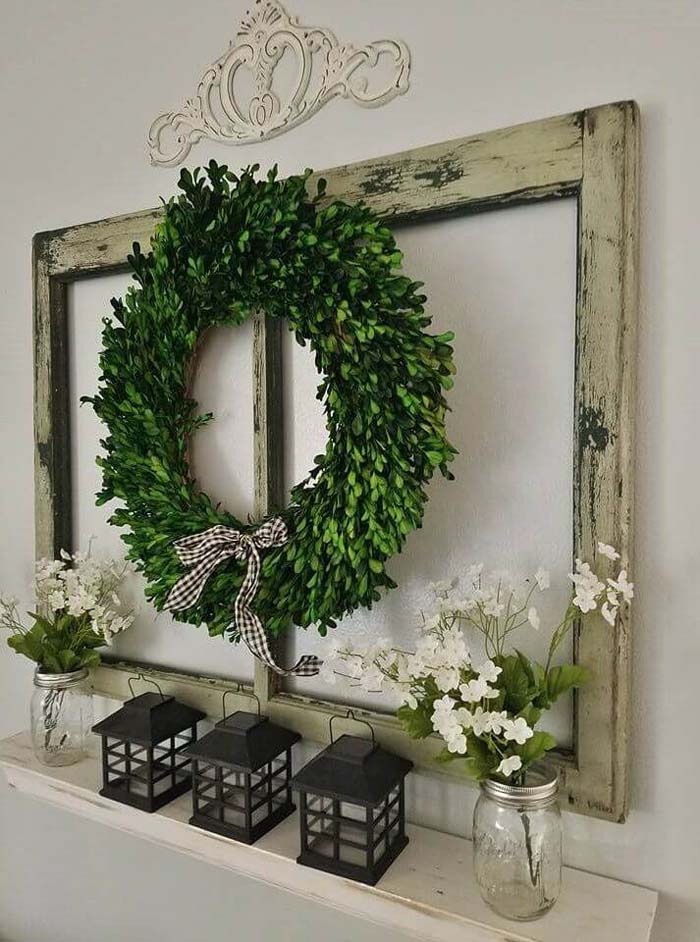
If you don’t have a mantle to display your farmhouse decoration, you can create a special wall nook for them.
A floating shelf from a weathered beam accommodates jar vases and black garden lanterns to welcome the outdoors inside.
The presence of the outer farmhouse world is enhanced by the wall art continuing the shelf arrangement represented by a repurposed window frame completed with a faux boxwood wreath.
Give Your Home a Modern Edge with Rustic Accents
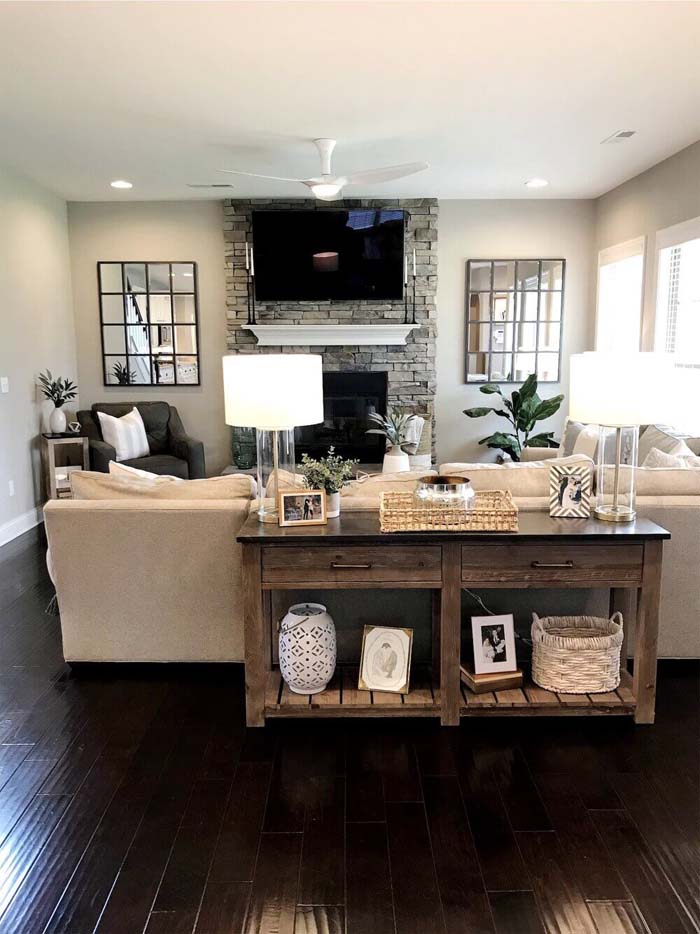
The farmhouse living room decor ideas can be given a contemporary look if you add modern touches.
This rustic home decor idea combines the typical rural materials such as stone and wood with modern light fixtures, glass and mirror accents.
Although these are only accents to the basic decor style, they manage to give it a more contemporary look.
Create a Rustic Coastal Wonderland in Your Living Room
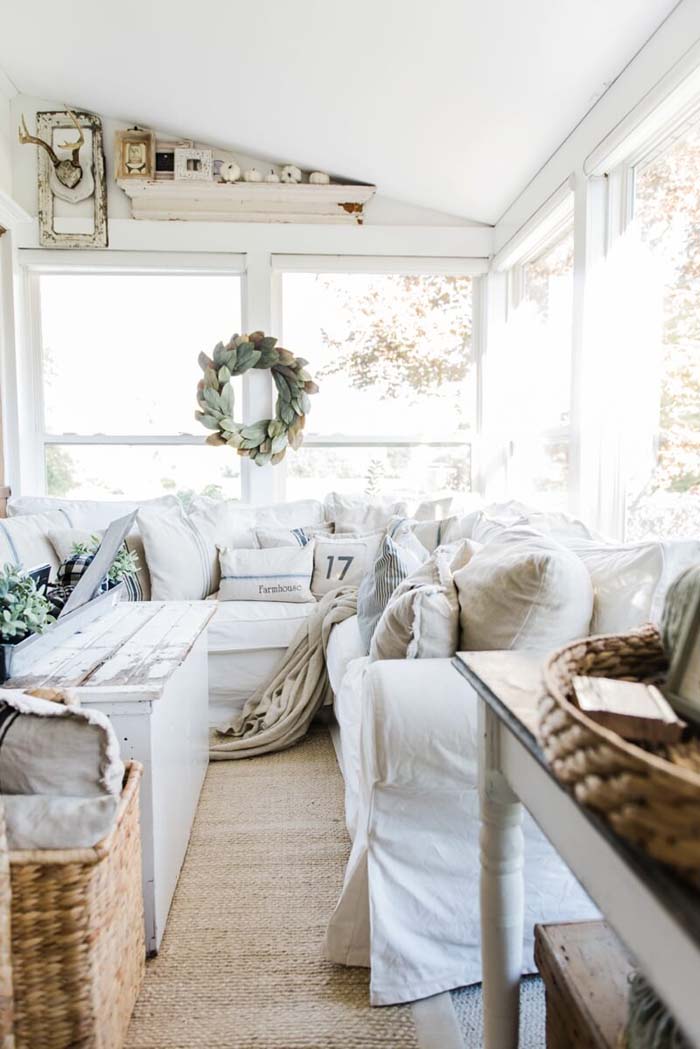
Mixing blue, light green and sandy colors give a rustic farmhouse living room a coastal touch.
Whitewashed wooden surfaces, rattan containers, comfy linen-covered sofas and a jute rug set the sitting area.
Eucalyptus leaf wreath decorates a wide window letting warm natural light come through.
The wicker baskets spread here and there contain smaller rustic items that make this sunny living space more inviting.
Spruce Up Decor with Armchair and a Corner Quilt Display
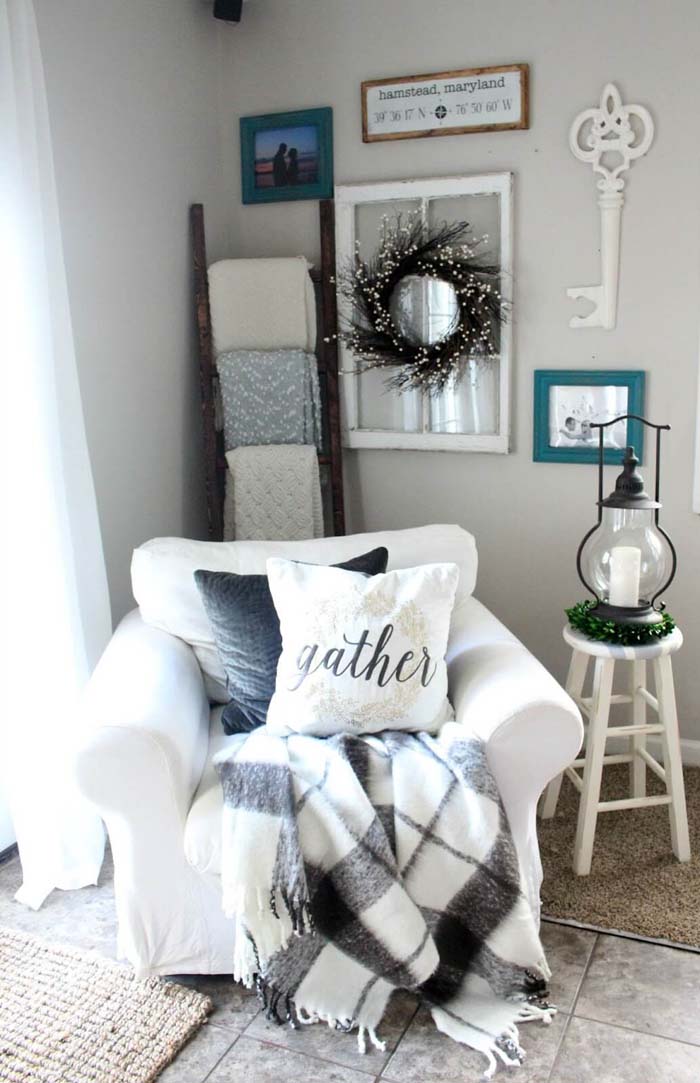
The cozy armchair in the living room is the favorite spot for privacy and relaxing. Turning it into part of a farmhouse nook will enhance its inviting vibe.
It is easy to achieve that by adding some particular elements to it. Cover it with a white or light brown cover. Add a throw and a few throw pillows on it.
Surround it with rustic accents that will let the room embrace the farmhouse armchair.
A ladder with blankets, signs, a wreath hung on a repurposed window, a gas lamp on a rustic accent chair.
Enjoy Fall with a Cozy Rustic Sitting Area Arrangement
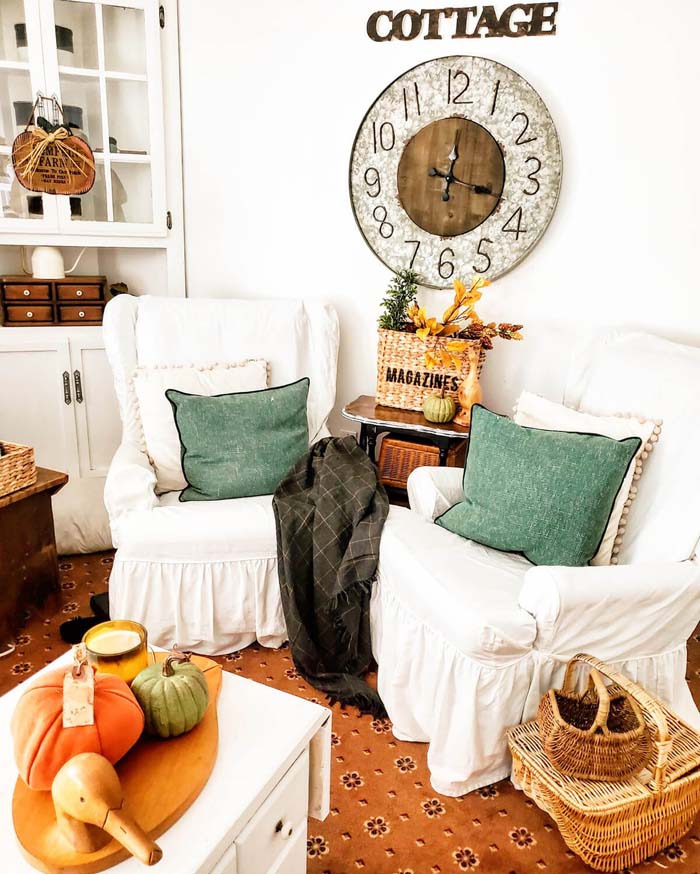
Nature at fall is so warm and welcoming! Transfer its spell into the inside of your living room to create a relaxed and cozy atmosphere.
Farmhouse style is represented by multiple warm colors in the fall palette, natural textures and the typical pumpkin symbol.
Pillows and throws enhance the warm vibe and welcome you to sit there and take off all your cares.
Give a Couch a Farmhouse Makeover with Linen Slipcovers
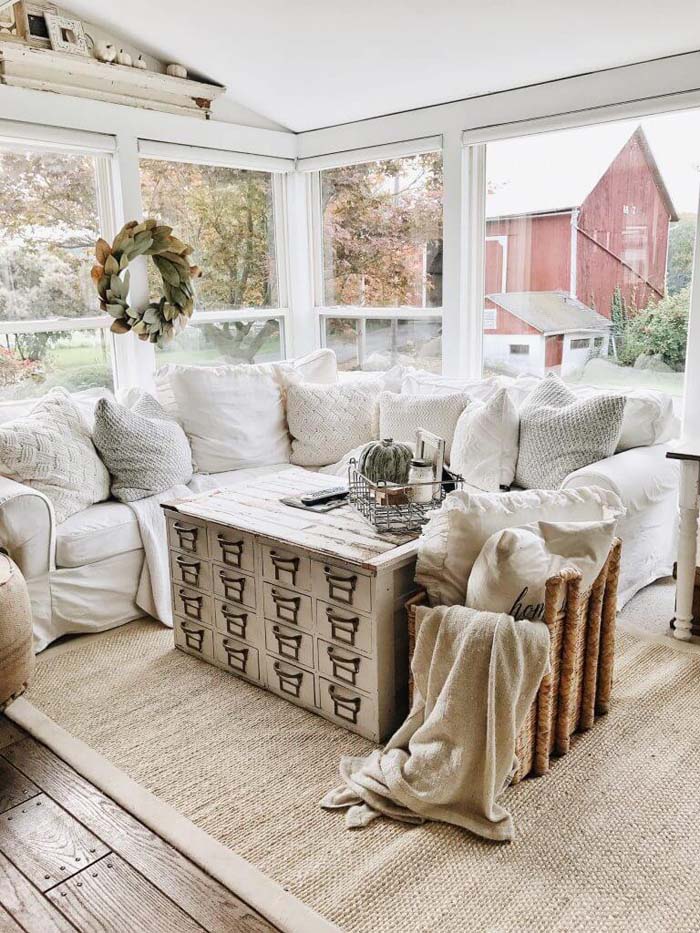
You can give an existing couch a farmhouse look in a budget-friendly way.
Instead of changing it for a rattan set, you can purchase or sew yourself a linen or burlap slipcover.
It is easy to be maintained and gives the sofa a total transformation. Combine with an antique coffee table, a few knitted throws and pillows covered with a coffee sack or burlap pillows.
A wreath and pumpkins in a wire basket add a pop of green color to the neutral setting and make this sunny farmhouse-style living room a magical place.
Add a Color Accent
:max_bytes(150000):strip_icc():format(webp)/5426_210520_flanigan-a48b4ed9e93648d1afcf4d92f9355026.jpg)
While the farmhouse aesthetic tends to focus on neutrals, you can lift your decor with judicious color accents.
Marie Flanigan Interiors added definition to this airy living room with traditional barn red detailing.
Show Off Collectibles
:max_bytes(150000):strip_icc():format(webp)/camp_cal_living_rm_2-022_FINAL_1200-83b3424274f346fd9e1a52f1acced802.jpg)
This 1920s LA hunting cabin from Leanne Ford Interiors has a farmhouse vibe with its whitewashed wood, rustic stone fireplace, lightly pitched roof, visible ceiling beams, and assortment of personal objects scattered around the room that feel collected over time rather than overly styled.
Source a Vintage Mantel
Add authenticity to a farmhouse living room by sourcing vintage and antique accent pieces that will give the space a sense of history.
Becca Interiors highlighted a brick fireplace with a vintage natural wood mantel in this beaded shiplap-clad coastal farmhouse living room in Southampton Village, NY.
Try a White Farmhouse Floor
Paint the floorboards white for a Scandi-inspired farmhouse feel.
In this cozy living room from Liz Marie Blog, a vintage-style Antiques sign on the rustic wood mantel complements the all-white room.
Mix and Match Styles
:max_bytes(150000):strip_icc():format(webp)/ConnecticutFarmhouse-2_447-3f14d416511744efa7caa3010b0cf54f.jpg) Design by Kara Mann
Design by Kara Mann
Create an authentic farmhouse feel by mixing and matching furniture styles rather than going for a uniform look.
Interior designer Kara Mann chose an eclectic mix of furniture and decor in this Connecticut farmhouse to add interest and texture while keeping the focus on the room’s original character, with its simple lines, small farmhouse windows, and rustic dark wood ceiling beams.
Add Overstuffed Seating
This farmhouse living room from AHG Interiors is dominated by a rustic stone fireplace and flanked by an overstuffed chaise that offers a cozy place to curl up by the fire.
Highlight Natural Stone
:max_bytes(150000):strip_icc():format(webp)/oshie_-_julie_soefer_112-9262012404e9484993171ffe3ba5d2fe.jpg)
In a transitional living room, highlight natural materials to channel a farmhouse feel.
A rustic stone wall is the focal point of this space from Marie Flanigan Interiors.
Accent With Moody Paint
:max_bytes(150000):strip_icc():format(webp)/mindy-gayer-neillie-gail-WEB-124-1-7ffde97809094e318c79b4818fe93946.jpg)
Use moody paint to create a cozy feel.
Mindy Gayer Design Co. uses matte black paint on the fireplace and wall of open storage that add a grounding note in a room with soaring ceilings and pale wood exposed beams.
The room is accessorized with accents like a pair of landscape paintings on the mantel, and an upright piano that adds a homey touch.
Hang a Classic Chandelier
:max_bytes(150000):strip_icc():format(webp)/farm-house-fresh-bronze-and-white-living-room-58de8e52890a84749952081a-w1000_h1000-4cdc783048ed41f9ad4ffb6731318951.jpg)
This light-flooded, white-walled living room Leanne Ford Interiors has an elegant farmhouse feel thanks to shelves of collected objects, a cozy overstuffed sofa, and an antique crystal chandelier that hangs proudly in the center of the room.
Modernize With Pattern
:max_bytes(150000):strip_icc():format(webp)/PoundRidge31064-8f85f9dccf0e4aabb3bf3a0185146a5f.jpg) Design by Kara Mann
Design by Kara Mann
Add a modern feel to a historic farmhouse living room with patterned textiles.
This Westchester, NY farmhouse from interior designer Kara Mann has wrap-around windows in the living room flanked by patterned curtains that can be drawn at night for a cozier feel.


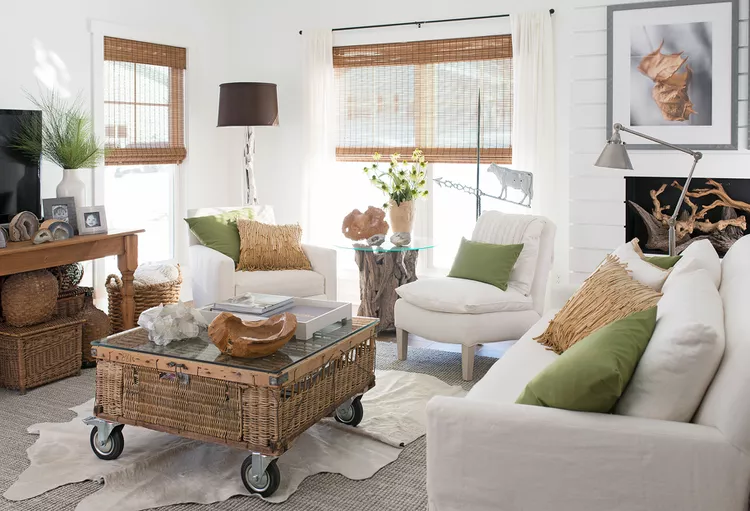
:max_bytes(150000):strip_icc():format(webp)/20201016_BeccaInteriors_Southampton-25-9b3c65ee8d9646fd9deeb66f1a403886.jpg)
:max_bytes(150000):strip_icc():format(webp)/IMG_1725-f730e750432d4e0fbe77b07a1871ab5d.jpg)
:max_bytes(150000):strip_icc():format(webp)/PeterMackenzie_AHG-19-cc9e1517e98e4312b7bbf4af7f1cb522.jpg)